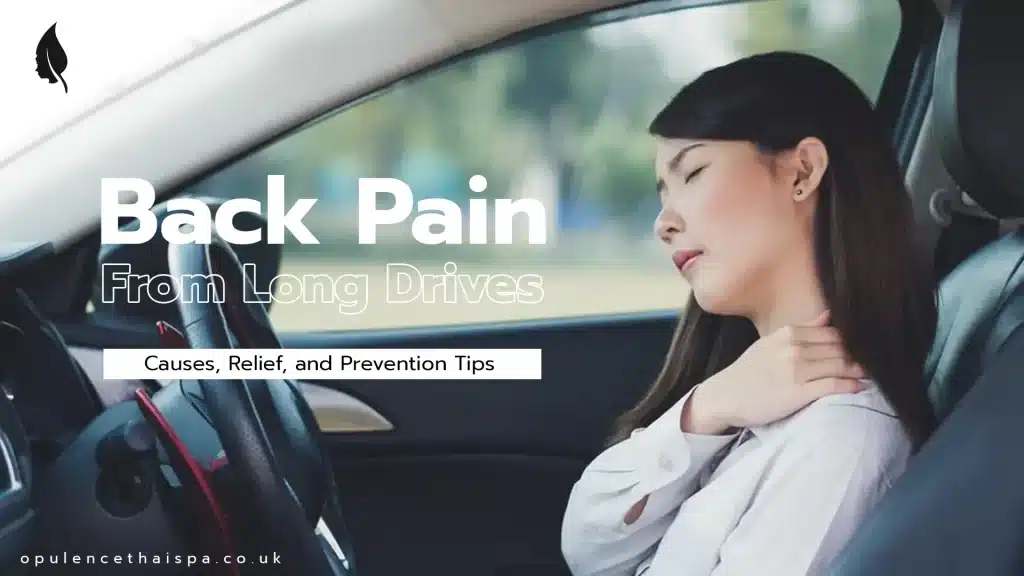Table of Contents
Driving long distances can be mentally liberating, especially on a road trip or a scenic countryside route. But for many, the joy of driving is quickly overshadowed by a nagging, throbbing, or even sharp pain in the back. Back pain from long drives is more common than you might think — and while it can affect drivers of all ages, it’s particularly problematic for frequent commuters, lorry drivers, and anyone who spends hours behind the wheel.
In this article, we explore the causes of back pain while driving, effective techniques for managing it, and smart prevention strategies to help you drive in comfort — no matter how long the journey.

Why Do Long Drives Cause Back Pain?
Unlike walking or standing, driving keeps your body in a fixed seated position for long periods. This unnatural posture places stress on your muscles, joints, and spinal discs. Several specific factors contribute to back pain from driving:
1. Poor Seat Ergonomics
Most car seats, especially in older models, lack adequate lumbar support. This forces the spine out of its natural S-shape, putting extra pressure on the lower back (lumbar spine).
2. Limited Movement
While driving, your ability to move or stretch is limited. This can cause muscle stiffness, reduced circulation, and ultimately pain, especially in the lower back.
3. Vibration and Road Impact
Continuous vibrations from the road, particularly in lorries or vehicles with hard suspensions, can lead to spinal fatigue and muscular tension.
4. Incorrect Posture
Many drivers unconsciously hunch over the wheel or slump in their seats. Over time, this poor posture exacerbates spinal misalignment and muscle strain.

Common Symptoms of Driving-Related Back Pain
Recognising the signs early can help you take action before the pain becomes chronic. Common symptoms include:
- Aching or stiffness in the lower back
- Pain radiating to the buttocks or thighs (sciatic-like symptoms)
- Neck and upper back discomfort
- Tingling or numbness in the legs after long drives
- Difficulty straightening the spine after exiting the vehicle
If any of these symptoms persist, it’s advisable to consult a physiotherapist or GP.

How to Relieve Back Pain After Long Drive
If you’re already dealing with back discomfort after a drive, here are some helpful relief methods:
1. Stretch Immediately After Driving
Gentle stretching can restore circulation and release muscle tension. Focus on lower back, hamstrings, and hip flexors. A few yoga-inspired stretches like the cat-cow pose or child’s pose can work wonders.
2. Apply Heat or Cold Packs
Cold packs reduce inflammation, while heat packs help to relax tight muscles. Use whichever provides better relief, or alternate between both.
3. Massage Therapy
A good massage — whether professional or with a foam roller — can ease muscle knots and improve spinal mobility.
4. Over-the-Counter Pain Relief
If the pain is severe, non-prescription anti-inflammatories like ibuprofen can provide temporary relief. Always follow dosage recommendations and seek medical advice for ongoing use.

How to Prevent Back Pain While Driving
Prevention is better than cure. Below are evidence-based strategies to prevent back pain from affecting your journeys.
1. Adjust Your Seat Properly
Key seat adjustments to make:
| Adjustment | Ideal Position |
|---|---|
| Seat Height | Eyes at mid-windscreen, knees slightly lower than hips |
| Lumbar Support | Firm pressure on the lower back’s curve |
| Seat Back Angle | Around 100–110 degrees for upright comfort |
| Distance to Pedals | Knees should remain slightly bent when pressing pedals |
| Steering Wheel | Close enough to avoid hunching forward |
Use a small cushion or lumbar roll if your car doesn’t offer lumbar support.
2. Take Regular Breaks
For every 1.5 to 2 hours of driving, stop for at least 10 minutes. Walk, stretch, and move your spine to prevent stiffness. For long-haul drivers, this is not just helpful — it’s essential.
3. Strengthen Your Core
Your core muscles support your spine. Incorporating exercises like planks, bridges, or Pilates into your weekly routine can improve posture and reduce strain while sitting.
4. Use Ergonomic Accessories
Consider investing in:
- Lumbar support cushions for your seat
- Heated seat pads to soothe muscles
- Adjustable mirrors so you don’t have to crane your neck
5. Practice Conscious Posture
Always be aware of your posture. Sit tall, keep your shoulders relaxed, and avoid slouching or leaning on one arm.

Driving Professionally? Here’s What You Should Know
For lorry drivers, taxi drivers, or delivery personnel, back pain isn’t just an occasional issue — it’s an occupational hazard. According to the UK’s Health and Safety Executive (HSE), musculoskeletal disorders are among the top causes of work-related health issues in transport.
To reduce risk:
- Use vehicles with adjustable, ergonomic seating
- Report any faulty seat mechanisms to your employer
- Engage in regular physical activity outside of work
- Seek occupational health assessments if pain persists
When to Seek Medical Advice
While occasional soreness after a drive isn’t usually serious, persistent or worsening pain could indicate a more significant issue like a herniated disc, sciatica, or spinal stenosis.
Seek immediate medical attention if you experience:
- Pain that radiates down your legs
- Numbness or weakness
- Loss of bladder or bowel control
- Pain that doesn’t improve with rest or movement
Final Thoughts
Back pain from long drives is a widespread issue — but it doesn’t have to be part of your routine. With simple posture corrections, regular movement, and attention to your physical health, you can significantly reduce discomfort and keep enjoying the freedom of the open road.
Whether you’re heading out for a weekend getaway or commuting daily, remember: your spine deserves the same care and attention as your car. Adjust your seat, stretch often, and never ignore pain. Safe and comfortable travels!
FAQs
Q: Can a long drive cause permanent back damage?
A: Not typically, but prolonged poor posture and repeated stress without proper care can lead to chronic conditions.
Q: What’s the best seat cushion for driving back pain?
A: Memory foam cushions with lumbar support and tailbone cut-outs are highly recommended.
Q: Are automatic cars better for back pain than manual cars?
A: Yes. Automatics reduce the repetitive motion of clutching, which can ease hip and lower back stress, especially in traffic.

To ease tension and fully recover after a long drive, consider treating yourself to a professional Thai massage at Opulence Thai Massage in London. Our skilled therapists specialise in back and shoulder relief, using traditional techniques to release deep-seated muscle tightness, improve circulation, and restore posture. Whether you’re a commuter or just finished a road trip, a session at Opulence is the perfect way to unwind and give your back the care it truly deserves.
Founder and driving force behind Web Evolve Co., Ltd., a full-service website development and digital solutions company trusted by leading businesses across Thailand. With over 5 years of experience in the digital industry, he specializes in designing and developing websites that excel in both UX/UI and SEO — empowering businesses to grow sustainably in the digital world.











